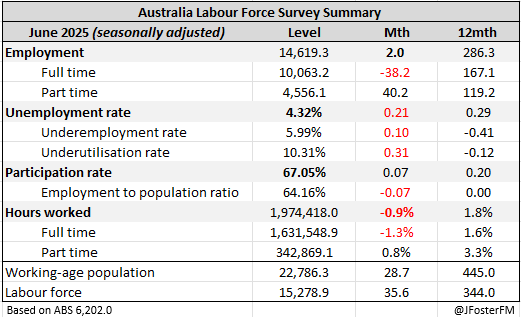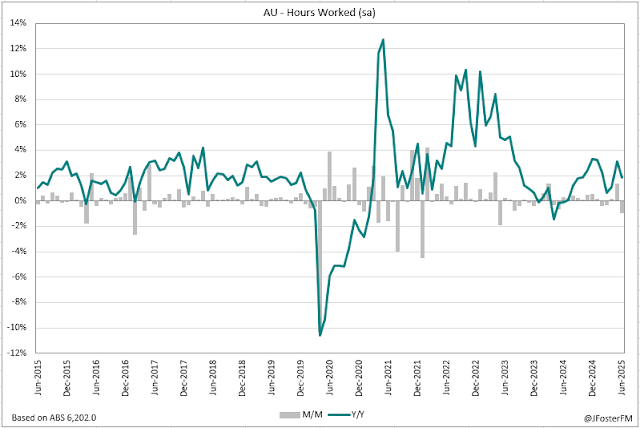Australia's unemployment rate has lifted to its highest level since November 2021, rising to 4.3% in June from the 4.1% level it had held since the start of the year. Today's poor report is untimely for an RBA that resisted widespread calls to cut rates earlier this month. Market reaction on the figure was strong ($AUDUSD -0.5%, 3-year yield -9bps) as the swaps market locked in a rate cut for the next meeting in August. While this RBA has shown it will move independently of market pricing, signs of softening in the labour market puts a different complexion on its disposition to wait for the quarterly inflation data due later this month.
By the numbers | June
- Employment increased by a modest 2k in June (full time -38.2k/part time 40.2k), well short of the 20k rise anticipated. The decline in employment in May was revised to a smaller fall of -1.1k from -2.5k previously.
- The unemployment rate rose to 4.3% against expectations for it to hold at 4.1%. With underemployment also ticking up from 5.9% to 6%, total labour force underutilisation increased from 10% to 10.3%.
- Labour force participation returned to 67.1% from 67%, reversing its decline from last month. The employment to population ratio was steady at 64.2%.
- Hours worked fell sharply by 0.9% on the month, slowing annual growth from 3.1% to 1.8%.
The details | June
There are signs that employment is cooling, with a net 2k rise in June (FT -38.2k/PT 40.2k) coming on the back of a 1.1k fall in May. Employment figures have been hugely volatile this year, but today's report makes it soft outcomes in back-to-back months.
The overall picture on employment is still solid: employment increased by 86.4k for the June quarter - its strongest quarterly rise since Q3 last year - and gains in the period averaged out at a decent run rate of 28.8k per month. But with all the heavy lifting on employment having been done in April (85.5k), the slowdown in May-June is worth exploring.
Developments such as the announcement of the Trump Administration's tariff regime and the federal election domestically may have led to more caution around hiring than earlier thought. An alternative viewpoint is that hiring in the non-market (government) sector may be slowing, the segment that has kept employment well supported amid the slower growth backdrop in Australia - but the federal election may have also played a role here.
Although there is a lot of uncertainty around the dynamics, slower employment means the unemployment rate has started to move up. A fall in participation prevented the unemployment rate from creeping higher last month, but with participation going on to rebound to 67.1% in June the unemployment rate shot up to 4.3%, a 43-month high. Unemployment averaged 4.2% across the June quarter - still a low level - and the averages of the broader measures of underemployment (6%) and underutilisation (10.1%) were also low. Slower employment, if sustained, will see these measures loosen, so this will need to be monitored.
Hours worked have swung around with the volatility in employment. In June hours worked were down 0.9% on the month; however, hours worked lifted by 0.4% in the quarter - a little below the increase in employment (0.6%).
In summary | June
Robust labour market conditions played a key role in the RBA's decision to hold rates steady at last week's meeting, with the Board signalling its preference to wait for the quarterly inflation data. But given today's report where question marks have emerged around the labour market, that narrative seems much less likely to survive the RBA's next meeting in August - even if inflation shows a little less progress than desired.








